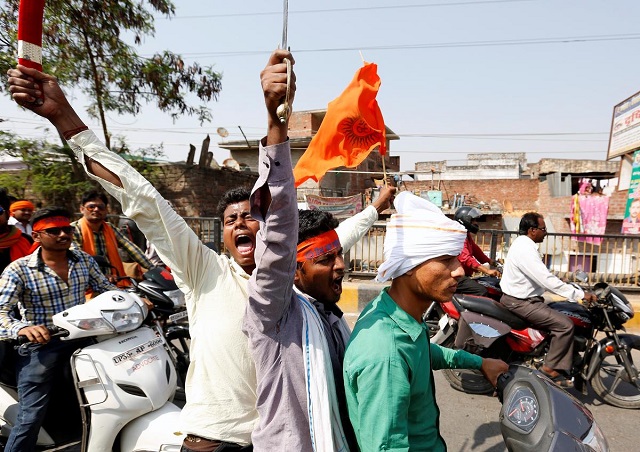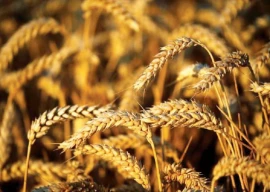
PM Modi and his party believe in implementing the central tenets of the BJP manifesto —Hindutva or “being a Hindu”. Hindutva first appeared in the mid-1880s in an Indian fiction novel. However it was espoused as an ideology by an ultra-right Hindu ideologue, Vinayak Damodar Savarkar (1883-1966), in 1923. It is adopted by the ultra-nationalist Hindu organisations like the RSS, Hindu Sena and Vishva Hindu Parishad (VHP) among others. The ideology promotes the concept of an “India for Hindus only”, where Hindus as a homogeneous majority would dominate the cultural, economic, spiritual and political landscape.
National identity under Hindutva is based upon the Hindu religions, including Jainism, Buddhism, Hinduism and Sikhism, and excludes monotheist religions like Islam and Christianity. The ideology believes in reverse-conversion of erstwhile adherents of the Hindu religions, who or their forefathers had adopted foreign religions like Islam and Christianity. However, Savarkar considered Muslims as the actual foe, since Islamic ideology ostensibly posed a threat to the Hindu nation or Rashtriya. Today, Islam and Muslims are perceived as stumbling blocks against the aspirations of the Hindu ultra-right.
The Indian Supreme Court records of 1990s, lists seven landmark judgments, the “Hindutva judgments”, in a legal riposte to tone down the exclusive and prejudiced meaning and manifestation of the ideology. However, factually the Hindutva has always played a divisive role in Indian politics and public life. It was the Hindutva-inspired and Arya Samaj driven Shuddhi (reverse conversion of non-Hindus) and the Sangathan (Hindu solidarity in communal violence) movements of the Partition days that played a pivotal role in creating Pakistan. But never before was Hindutva center stage in India, as it is now under Modi. It is an irony that politics in modern and so-called-secular India has degenerated to such a narrow exclusivity in the 21st century. This cynic interpretation of nationalism is accelerating the dying pangs of Indian secularism that were touted for so long to the world. In a new normal, political discourse in India thrives by whipping up ultra-nationalist and religion-based xenophobia. It puts context to the continuing communal violence, the carnage of the Partition and the ongoing brutal occupation of Muslim majority Kashmir.
The BJP and PM Modi’s Hindutva-inspired abhorrence for Muslims is no secret. The Gujarat massacre of Muslims under Modi’s watch is not too distant a memory. Today, the largest democracy of the world deploys thousands of troops in an unprecedented lockdown ostensibly to “protect the Kashmiri population” and maintain the “public order”, to paraphrase the Indian Ambassador to the UN, Syed Akbaruddin, speaking after the August 16 meeting of the UNSC, convened to discuss the Kashmir Crisis. His lack of conviction during the televised comments betrayed his inner feelings and guilt in supporting a morally bankrupt position was so evident.
The BJP and PM Modi’s compulsions and aspirations vis-a-vis the Hindutva ideology make a useful study. In a country with more than 2,000 jatis (castes), almost all major religions and sects, numerous languages and dialects — that contributing scholars of Encyclopedia Britannica cannot put a number on them — centrifugal forces are always at work. Religious, cultural, linguistic and political fault lines are ever present and exploitable. India almost always succumbed to the invaders (early on Muslim, and later the British) who readily exploited these divisions. Erstwhile the Indian and present BJP leadership, in its efforts to bridge these divisive gaps, have tried promoting the chauvinistic Hindutva ideology to unite the disparate population in one big homogenous whole, the Hindu Rashtriya, just like the Congress galvanised masses around secularism as a common platform. However, political expediency at the cost of ignoring the ground realities can have costly implications. The genie of bigotry and intolerance once out cannot be bottled.
Proponents of this ideology believe that greater India unified under Hindutva and the stewardship of PM Modi, would lead to greatness — portrayed in the fables of the Mahabharata, that are screened proudly and persistently by Indian TV. A nationalist fervour engulfing and resulting in the majority Hindu rule would presumably enable India to reclaim its rightful place in the region and the world at large, finally breaking with some periods of its humiliating past. Actions such as the demolition of the Babri mosque and others, along with churches that have either been destroyed or rendered disputed, changing the names of cities, forced conversions of Muslims and Christians, declaring over four million people in Assam as non-citizens and constraining them to refugee camps, and the mushrooming of saffron-clad vigilantes are grotesque expressions of this murderous ideology. Dharma Jagran Samiti leader, Rajeshwar Singh has repeatedly called to “finish” Christianity and Islam in India by 31 December 2021. The recent statement by the Indian Defence Minister, Rajnath Singh, about reconsidering India’s no-first-use (NFU) nuclear policy is also a muscular manifestation of the Hindutva. The world should be worried about Indian nukes in the hands of saffron-clad extremists.
Deep down, Hindutva — the ideology employed by the BJP, sociologically and psychologically — is nursed by an inferiority complex, with a desire to redress all the supposed wrongs that were historically done to Hindus, especially by Muslims. This inferiority complex manifests itself in an outward expression of superiority. Meddling in the Maldives, Sri Lanka, Bangladesh, Nepal, Bhutan and spurning Pakistani overtures for dialogue are some dangerous cases in point.
Paradoxically the same effort to bond the majority Hindu population results in alienating the minorities, which in the case of India are significant with around 200 million Muslims, 29 million Christians and 200 million low-caste Dalits, scheduled castes and others. In a country of 1.3 billion people, Hindutva-driven violent chauvinism is and would be catastrophic. Bigotry, exclusivity, intolerance and prejudice in an Indian society consisting of multiple ethnicities, cultures and religions can unravel the country’s foundation. Indian founding fathers understood this and grudgingly supported secularism after the carnage that was Partition. Modi may be the harbinger of more Pakistans borne out of India. It is only a matter of time. Dark clouds over Kashmir have an ominous silver-lining.
Published in The Express Tribune, August 27th, 2019.
Like Opinion & Editorial on Facebook, follow @ETOpEd on Twitter to receive all updates on all our daily pieces.












































COMMENTS
Comments are moderated and generally will be posted if they are on-topic and not abusive.
For more information, please see our Comments FAQ